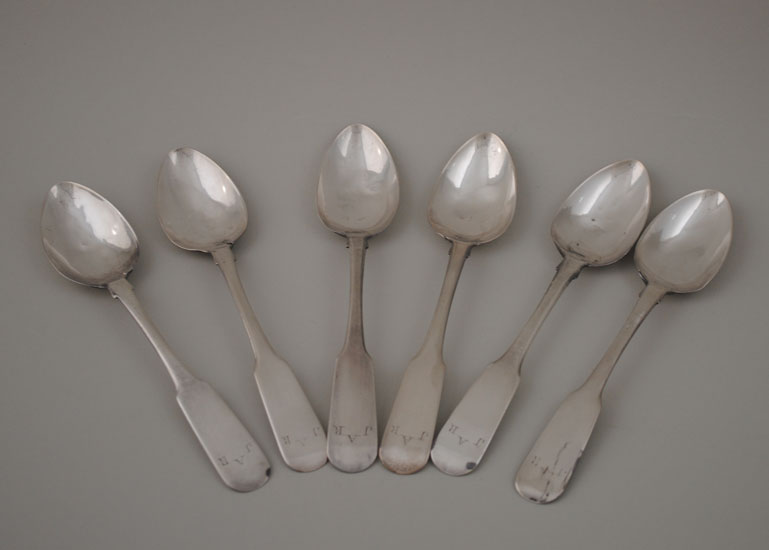
Borders & Frontiers (1800-1820)Joseph & Allie Ruttan's Spoons |
|||
|
|||
Joseph Ruttan's Six Silver Teaspoons |
Six silver teaspoons were handed down from John Canniff Ruttan and Sarah Baillie who lived east of the Great Cataraqui River in Pittsburgh Township. John was the second son of Joseph Brant Ruttan who died on 12 January 1832 in Adolphustown Township. An inventory of his estate was made on 21 March 1832 and among the long list of possessions were six large silver spoons valued at 105 shillings each and 12 silver teaspoons valued at 5 shillings 10 pence each. While each surviving child of Joseph Brant Ruttan received a portion of his estate according to his will of 14 November 1831, the disposition of the numerous minor items, including the spoons, is not mentioned, except that they were to be divided equally among the nine heirs. It would appear that John Canniff received six of the teaspoons. DISCOVER MORE![]()
The teaspoons have two separate parts, each of different materials. The ladle part is of almost pure silver, while the handles are made of a silver alloy, which makes them stiffer and stronger. A drop of silver solder holds the two parts together. Near the end of the handle are three engraved initials "J A R." On the back is the silversmith's mark of Spanenberg, who was in business in Kingston from 1845 to 1870.
The engraved initials stand for Joseph, Allie (variously Aulay or Ally) Ruttan. Allie was the name of Joseph's wife. She was born Allie Canniff, daughter of John Canniff UE. Allie was one of the first children born in Adolphustown after the arrival of the first Loyalist party under Major VanAlstine in June 1784. Joseph was a son of Captain Peter Ruttan, of the New Jersey Volunteers. Joseph and Alley were married in 1805.
To discover the origin of the spoons, one has to rely on family tradition. Joseph Ruttan served during the War of 1812 in the flank company of the 1st Regiment of Lennox Militia from the 27th of June to the 31st of December 1812. He was paid for his service in Spanish silver coinage, which he had melted down to make the spoons. Why Spanenberg's mark is on the spoons is a mystery, unless he replaced the handles after 1845.
These six spoons represent a piece of the early history of Upper Canada. They were a direct result of the War of 1812, and the service of one of Upper Canada's first-born, son of a distinguished Loyalist.
© Lennox & Addington County Museum & Archives
97 Thomas Street East, Napanee, Ontario, Canada K7R 4B9
Funding provided by the Government of Ontario and the County of Lennox & Addington




